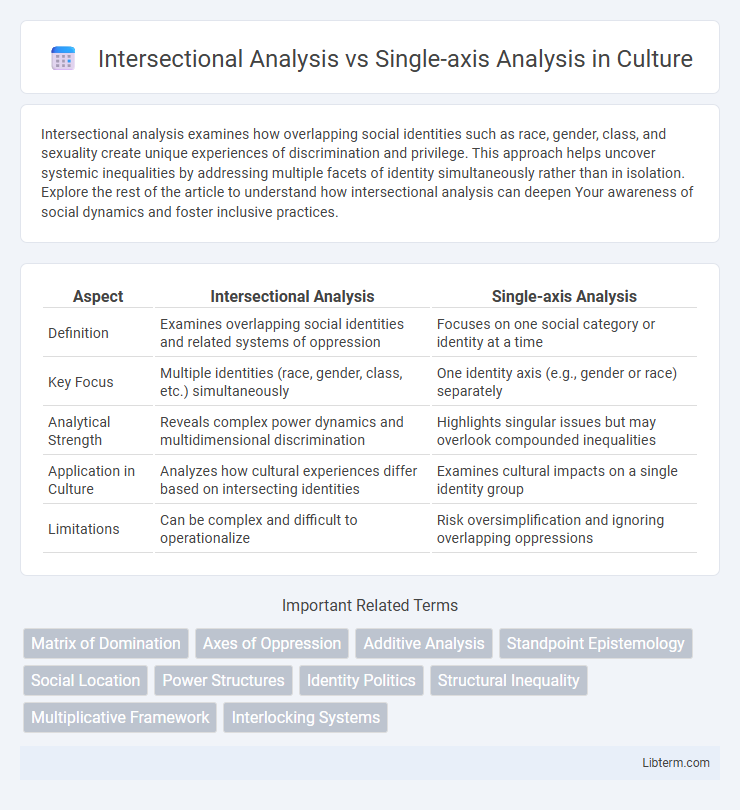Intersectional analysis examines how overlapping social identities such as race, gender, class, and sexuality create unique experiences of discrimination and privilege. This approach helps uncover systemic inequalities by addressing multiple facets of identity simultaneously rather than in isolation. Explore the rest of the article to understand how intersectional analysis can deepen Your awareness of social dynamics and foster inclusive practices.
Table of Comparison
| Aspect | Intersectional Analysis | Single-axis Analysis |
|---|---|---|
| Definition | Examines overlapping social identities and related systems of oppression | Focuses on one social category or identity at a time |
| Key Focus | Multiple identities (race, gender, class, etc.) simultaneously | One identity axis (e.g., gender or race) separately |
| Analytical Strength | Reveals complex power dynamics and multidimensional discrimination | Highlights singular issues but may overlook compounded inequalities |
| Application in Culture | Analyzes how cultural experiences differ based on intersecting identities | Examines cultural impacts on a single identity group |
| Limitations | Can be complex and difficult to operationalize | Risk oversimplification and ignoring overlapping oppressions |
Understanding Intersectional Analysis
Intersectional analysis examines how overlapping social identities such as race, gender, class, and sexuality create interconnected systems of oppression and privilege, offering a comprehensive understanding of complex social inequalities. Unlike single-axis analysis, which isolates one identity factor at a time, intersectionality reveals the multidimensional nature of discrimination and highlights the unique experiences faced by individuals at the intersections of multiple marginalized groups. This analytical framework is essential for developing inclusive policies and practices that address the nuanced realities of diverse populations.
Defining Single-axis Analysis
Single-axis analysis examines social identities or categories such as race, gender, or class in isolation, often ignoring the interconnectedness of these factors. This method simplifies complex experiences by treating each axis of identity as separate and independent, potentially overlooking overlapping systems of oppression. It contrasts with intersectional analysis, which considers multiple identities simultaneously to better understand compounded social inequalities.
Historical Roots of Analytical Frameworks
Intersectional analysis traces its historical roots to Black feminist thought and critical race theory, highlighting how multiple social identities such as race, gender, and class intersect to shape experiences of oppression. Single-axis analysis, rooted in traditional social science methodologies, tends to examine social categories like gender or race independently, often overlooking overlapping systems of power. The evolution from single-axis frameworks to intersectional approaches reflects a broader recognition of complexity in social identities and systemic inequalities.
Core Differences Between Intersectional and Single-axis Approaches
Intersectional analysis examines multiple, overlapping social identities and related systems of oppression or privilege, revealing how race, gender, class, and other factors intersect to shape unique experiences. Single-axis analysis isolates one dimension, such as gender or race, analyzing it independently without considering interconnected influences. The core difference lies in intersectionality's multidimensional approach versus single-axis's singular focus, offering a more comprehensive understanding of social inequalities.
Advantages of Intersectional Analysis
Intersectional analysis provides a comprehensive understanding of how multiple social categories such as race, gender, class, and sexuality interconnect to influence individual experiences and systemic inequalities. It reveals complex power dynamics and overlapping forms of discrimination that single-axis analysis often overlooks, enabling more effective and inclusive policy-making and advocacy. By addressing the multifaceted nature of identity and oppression, intersectional analysis fosters nuanced solutions that better reflect diverse lived realities.
Limitations of Single-axis Analysis
Single-axis analysis often overlooks the complex interactions between multiple social identities, resulting in an incomplete understanding of systemic inequalities. It tends to isolate factors such as race, gender, or class without considering how these dimensions overlap and reinforce one another. This limitation can lead to policies and interventions that fail to address the nuanced realities faced by marginalized groups.
Practical Applications in Social Research
Intersectional analysis enhances social research by examining how overlapping identities such as race, gender, class, and sexuality create unique experiences of discrimination and privilege, leading to more nuanced data interpretation. Single-axis analysis, in contrast, isolates a single identity factor, which may oversimplify complex social dynamics and result in incomplete or skewed findings. Employing intersectional frameworks in surveys, policy assessments, and program evaluations improves accuracy and inclusivity, informing more effective interventions that address multiple dimensions of inequality.
Case Studies: Intersectional vs Single-axis Outcomes
Case studies reveal intersectional analysis captures more nuanced outcomes by addressing overlapping social identities, such as race and gender, unlike single-axis analysis which isolates variables and often overlooks compounded discrimination. For example, intersectional frameworks in healthcare research identify unique barriers faced by minority women, leading to targeted interventions that single-axis approaches miss. These findings highlight intersectional analysis's critical role in formulating comprehensive policies that better address multifaceted inequalities.
Challenges in Implementing Intersectionality
Implementing intersectionality faces challenges such as data scarcity and complexity in capturing overlapping social identities like race, gender, and class within single datasets. Single-axis analysis often simplifies social issues by isolating one identity factor, ignoring how multiple identities interact to shape unique experiences of discrimination. Intersectional frameworks demand nuanced methodologies and interdisciplinary approaches to accurately reflect systemic inequalities and address gaps left by traditional single-axis models.
Future Directions in Analytical Methodologies
Future directions in analytical methodologies emphasize integrating intersectional analysis to capture the complex interplay of multiple social identities, moving beyond the limitations of single-axis analysis that isolates variables like race or gender. Advanced computational models and machine learning algorithms are being developed to process multifaceted data sets, enabling nuanced insights into how overlapping systems of oppression affect outcomes. Embracing these multidimensional frameworks will enhance policy development and social research accuracy by reflecting real-world diversity and interconnected experiences.
Intersectional Analysis Infographic

 libterm.com
libterm.com